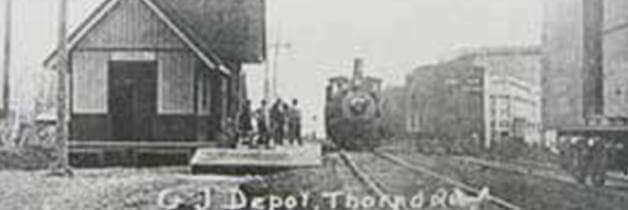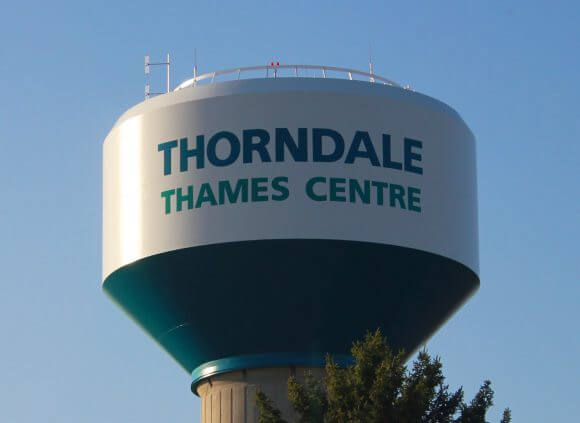Youth created History of Thorndale Video
Laying the Tracks for the Future
By Nancy Abra
Before the 1850’s, the present site of the Village of Thorndale was the dense wilderness property owned by the Logan family. It wasn’t until 1857, did the Logans survey their property along the line of the Grand Trunk Railway as a village site. The name Thorndale was chosen for the village in recognition of the importance of the Shanly family to the area. Also Walter and Francis Shanly, sons of early settler James Shanly, were top-ranked civil engineers and it is not known if they personally were involved in the construction of the Grand Trunk Line from Stratford to
London but they were very well known for their engineering marvels and saw to the construction of more miles of railroad than any other engineers in North America. The Grand Trunk Railway was unable to buy a lot for a station at Wyton, a small but growing settlement southwest of Thorndale, so they went on to Thorndale. When the Grand Trunk came through in 1858 and with the building of a station and rail freight sheds that year, the village of Thorndale was placed on the map. The railway was an essential link to the outside world as it opened up new markets for wood, timber, farm produce, and other goods produced in the Village and area.

In those early years, the village of Thorndale had a population of only 75 but housed a post office, saloon, wagon-maker, book dealer, tailor, painter, carpenter, shoemakers and store. The village quickly grew and by the 1880s, Thorndale was considered one of the most important shipping centres of the area. From this point, the railway provided the gateway to the markets of London, Toronto, and Montreal and as far away as Europe for local livestock and farm produce. Today, anyone driving through Thorndale will notice the mural painted on the east wall of the feed mill, facing the railroad track. In 1999, Dick and Trudy Nieuwland
commissioned London artist, Fred Harrison to paint a railroad scene (on the original station site) as their way to help preserve the historical importance of the railway to the village of Thorndale. This mural has become a Thorndale landmark marking the significant role the rail system played in early development and growth of Thorndale, as well as being the community’s lifeline.
The village of Thorndale – ‘rooted in history, growing for tomorrow’.



Setting Down Roots for Thorndale
By Nancy Abra

At one time or another, one might wonder about their roots or family heritage. While listening to family stories, leafing through that old treasured family photo album or even rummaging through that tattered shoebox of yellowed newspaper clippings and old receipts, one might contemplate their family’s legacy. This may be also true of the village or town where one lives, as most small communities of rural Ontario have interesting stories in regards to their humble beginnings.
The village of Thorndale is not an exception to this statement and would probably not be located where it is or even would not be so named if it had not been for the early settler of James Shanly and his family.
After selling his properties in Ireland, James Shanly, his wife and children made the seven-month journey to the promise land of Canada. This expedition, encountering all types of severe conditions, would include a mid-Atlantic crossing, canal boat trip from New York to Lake Ontario, passage from Toronto to Hamilton and finally a cart ride on to London over the bumpy and muddy terrain.
In the spring of 1837, James Shanly made a short investigative trip northeast of London to find some property for his new Canadian home. Captivated by the ghostly beauty of blooming hawthorn bushes and the natural beauty of a piece of property overlooking the valley of the Thames River, he purchased this 600-acre site on west side of Conc.2 (now Nissouri Road just north of the Thorndale Road).
He constructed a square frame house complete with a central hall, servant’s wing and spacious veranda, a smoke house and other buildings necessary for life of those days. Even though the township of West Nissouri was surveyed in 1818, any roads that existed where basically no more than rough cart trails, finding the proper building materials and even the skilled labour to build his home was very difficult. One must admire the determination of our early settlers as they build a home in that remote rural location in 1837.
Some sources claim James Shanly named his new home ‘Thorndale’ after his home in Ireland and in recognition of the natural beauty of the property. Other sources may argue that he chose the name of ‘Thorndale’ to describe natural terrain and the native thorn bushes.
Shanly made no effort to actively practiced law in this new Canadian home. But his home became a popular meeting place for the neighbourhood as people sought his advice and knowledge of his profession.
The Shanly family also founded a large distillery on the banks of Wye Creek. To many early settlers of the area and surrounding counties, the name ‘Thorndale’ was widely known as the home of the famed Shanly Whiskey. This potent drink was much smoother than the settlers’ homemade ‘rotgut’ and people would travel miles by cart or on foot to fill their stone jugs of this infamous drink, which would cost approximately 25 cents per gallon. To the delight of thirsty passers-by, there was even an old dipper, which hung by the distillery door for sampling, just as one might take a cool drink of water from a neighbour’s well.
Even though the ‘Thorndale’ Shanly Whiskey had a good solid reputation, the competition from other distilleries, being located on better roads and having readily accessible markets, forced the unprofitable distillery to close.
Today, the village of Thorndale sometimes is fondly referred to as ‘Prickly Valley’; the village’s legacy rooted out of those early beginnings and a colourful past.
Sources
- Thorndale Women’s Institute ‘Tweedsmuir History Book’
- West Nissouri Township ‘Our Heritage’ Volume One
- ‘Through the Years in West Nissouri’ by Ila Logan
